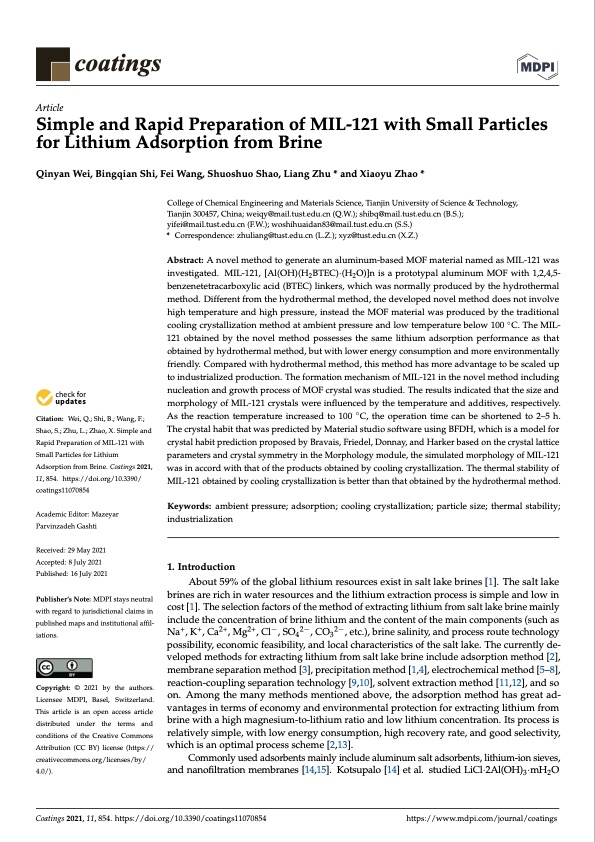
PDF Publication Title:
Text from PDF Page: 001
coatings Article Simple and Rapid Preparation of MIL-121 with Small Particles for Lithium Adsorption from Brine Qinyan Wei, Bingqian Shi, Fei Wang, Shuoshuo Shao, Liang Zhu * and Xiaoyu Zhao * Citation: Wei,Q.;Shi,B.;Wang,F.; Shao, S.; Zhu, L.; Zhao, X. Simple and Rapid Preparation of MIL-121 with Small Particles for Lithium Adsorption from Brine. Coatings 2021, 11,854. https://doi.org/10.3390/ coatings11070854 Academic Editor: Mazeyar Parvinzadeh Gashti Received: 29 May 2021 Accepted: 8 July 2021 Published: 16 July 2021 Publisher’s Note: MDPI stays neutral with regard to jurisdictional claims in published maps and institutional affil- iations. Copyright: © 2021 by the authors. Licensee MDPI, Basel, Switzerland. This article is an open access article distributed under the terms and conditions of the Creative Commons Attribution (CC BY) license (https:// creativecommons.org/licenses/by/ 4.0/). College of Chemical Engineering and Materials Science, Tianjin University of Science & Technology, Tianjin 300457, China; weiqy@mail.tust.edu.cn (Q.W.); shibq@mail.tust.edu.cn (B.S.); yifei@mail.tust.edu.cn (F.W.); woshihuaidan83@mail.tust.edu.cn (S.S.) * Correspondence:zhuliang@tust.edu.cn(L.Z.);xyz@tust.edu.cn(X.Z.) Abstract: A novel method to generate an aluminum-based MOF material named as MIL-121 was investigated. MIL-121, [Al(OH)(H2BTEC)·(H2O)]n is a prototypal aluminum MOF with 1,2,4,5- benzenetetracarboxylic acid (BTEC) linkers, which was normally produced by the hydrothermal method. Different from the hydrothermal method, the developed novel method does not involve high temperature and high pressure, instead the MOF material was produced by the traditional cooling crystallization method at ambient pressure and low temperature below 100 ◦C. The MIL- 121 obtained by the novel method possesses the same lithium adsorption performance as that obtained by hydrothermal method, but with lower energy consumption and more environmentally friendly. Compared with hydrothermal method, this method has more advantage to be scaled up to industrialized production. The formation mechanism of MIL-121 in the novel method including nucleation and growth process of MOF crystal was studied. The results indicated that the size and morphology of MIL-121 crystals were influenced by the temperature and additives, respectively. As the reaction temperature increased to 100 ◦C, the operation time can be shortened to 2–5 h. The crystal habit that was predicted by Material studio software using BFDH, which is a model for crystal habit prediction proposed by Bravais, Friedel, Donnay, and Harker based on the crystal lattice parameters and crystal symmetry in the Morphology module, the simulated morphology of MIL-121 was in accord with that of the products obtained by cooling crystallization. The thermal stability of MIL-121 obtained by cooling crystallization is better than that obtained by the hydrothermal method. Keywords: ambient pressure; adsorption; cooling crystallization; particle size; thermal stability; industrialization 1. Introduction About 59% of the global lithium resources exist in salt lake brines [1]. The salt lake brines are rich in water resources and the lithium extraction process is simple and low in cost [1]. The selection factors of the method of extracting lithium from salt lake brine mainly include the concentration of brine lithium and the content of the main components (such as Na+, K+, Ca2+, Mg2+, Cl−, SO42−, CO32−, etc.), brine salinity, and process route technology possibility, economic feasibility, and local characteristics of the salt lake. The currently de- veloped methods for extracting lithium from salt lake brine include adsorption method [2], membrane separation method [3], precipitation method [1,4], electrochemical method [5–8], reaction-coupling separation technology [9,10], solvent extraction method [11,12], and so on. Among the many methods mentioned above, the adsorption method has great ad- vantages in terms of economy and environmental protection for extracting lithium from brine with a high magnesium-to-lithium ratio and low lithium concentration. Its process is relatively simple, with low energy consumption, high recovery rate, and good selectivity, which is an optimal process scheme [2,13]. Commonly used adsorbents mainly include aluminum salt adsorbents, lithium-ion sieves, and nanofiltration membranes [14,15]. Kotsupalo [14] et al. studied LiCl·2Al(OH)3·mH2O Coatings 2021, 11, 854. https://doi.org/10.3390/coatings11070854 https://www.mdpi.com/journal/coatingsPDF Image | Small Particles for Lithium Adsorption from Brine

PDF Search Title:
Small Particles for Lithium Adsorption from BrineOriginal File Name Searched:
coatings-11-00854-v2.pdfDIY PDF Search: Google It | Yahoo | Bing
Product and Development Focus for Infinity Turbine
ORC Waste Heat Turbine and ORC System Build Plans: All turbine plans are $10,000 each. This allows you to build a system and then consider licensing for production after you have completed and tested a unit.Redox Flow Battery Technology: With the advent of the new USA tax credits for producing and selling batteries ($35/kW) we are focussing on a simple flow battery using shipping containers as the modular electrolyte storage units with tax credits up to $140,000 per system. Our main focus is on the salt battery. This battery can be used for both thermal and electrical storage applications. We call it the Cogeneration Battery or Cogen Battery. One project is converting salt (brine) based water conditioners to simultaneously produce power. In addition, there are many opportunities to extract Lithium from brine (salt lakes, groundwater, and producer water).Salt water or brine are huge sources for lithium. Most of the worlds lithium is acquired from a brine source. It's even in seawater in a low concentration. Brine is also a byproduct of huge powerplants, which can now use that as an electrolyte and a huge flow battery (which allows storage at the source).We welcome any business and equipment inquiries, as well as licensing our turbines for manufacturing.| CONTACT TEL: 608-238-6001 Email: greg@infinityturbine.com | RSS | AMP |